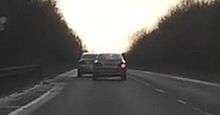Tailgating

Tailgating is the act of driving on a road too close to the vehicle in front, such that the distance between the two vehicles does not guarantee that stopping to avoid collision is possible.
The safe distance for following another vehicle varies depending on various factors including vehicle speed, weather, visibility and other road conditions. Some jurisdictions may require a minimal gap of a specified distance or time interval. When following heavy vehicles or in less than ideal conditions (e.g. low light or rain), a longer distance is recommended.
Causes
There can be several reasons for tailgating.
Negligence
Tailgating can occur because of a lack of perceived risk in so doing. Thus, it is done unconsciously or negligently, very often by people who consider themselves safe drivers and generally obey the other rules of the road. Evidence shows that more experienced drivers are more likely to be involved in rear-end collisions, possibly because they overestimate their skill and become complacent about allowing sufficient distance to avoid an accident.[1]
Coercion
In its most uncivic form, it can be a case of road rage and/or intimidation. An example would be where the tailgating driver (the driver in the following vehicle) threatens damage to the leading vehicle and its occupants by driving aggressively — perhaps also with use of headlights and horn — to bully the leading vehicle's driver to get out of the way. The driver being tailgated might not wish to comply, especially if doing so would involve breaking the law, such as by increasing speed beyond the speed limit or changing lanes without due regard for safety. Note, however, that in some jurisdictions flashing high beams is a normal and polite method used to signal the intention to overtake. Tailgating can also be dangerous to the tailgater, especially if they are driving closely behind a large vehicle (such as a tractor-trailer, or gas tanker). If the leading vehicle decelerates suddenly (such as when encountering a traffic jam, traffic lights, avoiding pedestrians, etc.), the tailgater has a high risk of causing a rear-end collision.
Aerodynamics
A form of deliberate tailgating known as slipstreaming, "draft-assisted forced stop", or "draft-assisted forced auto stop" (D-FAS) is a technique which has been used by people known as hypermilers to achieve greater fuel economy. D-FAS involves turning off the engine and gliding in neutral while tailgating a larger vehicle, in order to take advantage of the reduced wind resistance in its immediate wake.[2] Note that this practice is extremely dangerous: while tailgating itself is inherently risky, the danger of collision is increased with D-FAS as power for power brakes can be lost after a few applications of the brake pedal and, with older cars, the pressure that causes power steering to function can be lost as well.[3]
Trailing and columns
Another instance whereby the practice of driving on a road very close to a frontward vehicle or at a close distance may occur is during an occasion whereby the drivers of the two cars are acquainted to one another. This may be due to it being a procession of motor vehicles, typically carrying or escorting a prominent person that wants to avoid interlopers. Another instance may occur where the leading vehicle is showing directions to the trailing vehicle and the trailing vehicle attempts to avoid allowing an interloping vehicle to come in between them.[4] Another sphere wherein tailgating has been observed is among drivers who are in a hurry, or other public road activity whose prerequisite is urgency or agitation.[5]
Fighting against tailgating
Tailgating causes most rear-end crashes in South Australia.[6] Some motorways in the United Kingdom and Australia feature certain road markings which can help resolve this problem. Consisting of an arrangement of chevrons, these remind the driver not to tailgate, and assist in the two second rule.[7]
In Germany tailgating is punishable with a fine of up to €400. In case of gross negligence one or more penalty points are given and the driver's license may additionally be immediately suspended for up to 3 months.[8]
References
- Notes
- ↑ rms.nsw.gov.au
- ↑ motherjones.com
- ↑ motherjones.com, King of the hypermilers-2]
- ↑ McManus, John (2008). Tactical Emergency Medicine. p. 223.
- ↑ Hennessy, Dwight (2005). Contemporary Issues in Road User Behavior and Traffic Safety. p. 74.
- ↑ transport.sa.gov.au - Tailgating campaign
- ↑ au.news.yahoo.com
- ↑ "Abstand und Abstandsvergehen" [Distance and Distance Offense] (in German). 2015. Retrieved 4 February 2015.
External links
- Tailgating Information (Government of South Australia)
- TRAFFIC AND CRIMES AMENDMENT (MENACING AND PREDATORY DRIVING) BILL (New South Wales parliament Hansard transcript where tailgating is noted as being an offense under the new legislation).
- Tailgating Information (Wisconsin Department of Transportation)
- "Two Dots to Safety" campaign (operating in the United Kingdom and Europe, but also in Pennsylvania, Minnesota, Maryland, and Washington State)
- Police Force safety advice (Singapore)
- Report on an anti-tailgating operation (by the Hong Kong police)